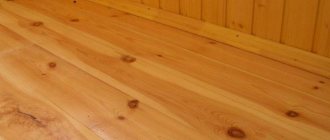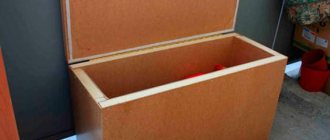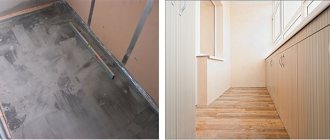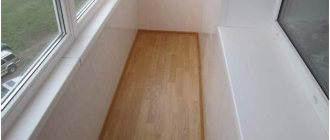The lack of a cellar is one of the inconveniences of living in an apartment in a multi-storey building. Vegetables and canned goods have to be kept in the garage, and if there is none, then storage becomes a “number one” problem. It is especially difficult when you have your own summer cottage, which produces good harvests of potatoes and other vegetables, but there is nowhere to store them.
The only way out in this situation is to make a cellar on the balcony: you don’t have to go far to buy the necessary products every time, and you can easily monitor their safety.
DIY cellar
Basic requirements for a cellar on a balcony
For vegetables stored for storage, it is necessary to create a certain microclimate, regardless of where they are stored, in a stationary cellar or on the balcony. The temperature throughout the winter is maintained between +1 and +5C, and air humidity is 85 – 90%. In such conditions, vegetables do not rot or dry out.
In ordinary basements and cellars, the desired mode is maintained by the simplest ventilation system - a pipe led outside, which is closed with a damper in severe frosts. It is more difficult to create suitable conditions on the balcony due to temperature instability: it can be too warm in autumn and spring, and too cold in winter. There are three ways to make a cellar on the balcony with your own hands.
Types of cellars for balconies:
- Container cellar;
- Cellar thermos;
- Heated cellar.
In addition to these three options, there is one more option - buy a ready-made cellar in a store. In terms of cost, it will cost more than a homemade cellar on the balcony, but the required temperature in it is maintained automatically.
Ready-made thermal cellars
Separately, mention should be made of the cellar on the balcony of the first floor - this is a full-fledged structure in which you can store large supplies of fresh vegetables and cans of preserves.
We do it ourselves
Many home craftsmen are interested in how to make a cellar on the balcony. Before starting work, the floor should be insulated. For this, foam sheets, polystyrene or mineral wool slabs are suitable. The top is covered with fiberboard, chipboard, thin board or plywood.
When the base of the balcony floor is prepared, the construction of the thermal container begins.
- sheet of chipboard or plywood;
- wooden slats and bars;
- insulation material;
- temperature regulating sensor;
- two 20 W lamps;
- cables;
- glue;
- tools - electric drill, hammer and nails.
- We build a box or box from boards or chipboard. We attach bars to the floor that will serve as the base. Vertical strut strips will be screwed to them, and rectangular frames will be installed.
- Using plywood and chipboard we make a box for the balcony (the distance between the double walls is about 10 cm). We put a heat insulator there.
- Inside the box we arrange shelves made of plywood and slats, and insulate the lid of the thermal container. The box needs holes for the wires.
- The plywood latch should move along the guides along the box lid. You need to make several holes in it (their diameter is 5 cm). The damper regulates the temperature by its movement.
- The heating function is performed by light bulbs. You can install a thermostat and thermometer inside the box to record the temperature. If electricity is needed, you need to connect the outlet to the balcony.
The thermal cellar is ready. The main disadvantage of such a homemade box is its susceptibility to moisture, and, as a result, the formation of mold and mildew. There is a risk of fire if the rules for installing heating elements are violated.
The result is a design that resembles a thermos - double walls with insulation between them. The lid of the box also needs to be made double and insulated with mineral wool, sawdust, thermal insulation made of foam plastic is suitable.
The thickness of the layer determines the reliability of protection of vegetables. This model without electricity for a balcony is suitable for regions with mild winters and well-insulated balconies.
If you don’t have enough time to make a balcony box yourself, you can buy a factory-made version.
There is a special prospect for ground floor apartments. Their residents don’t have to think about how to make a cellar on the balcony. They have a chance to build underground storage for canned food and vegetables. But the labor costs here are considerable.
- undergo approval and obtain an expert opinion that the construction of the cellar is safe for the building;
- cut a round or square hole in the balcony slab for the hatch, remove part of the concrete slab underneath, and remove a lot of soil;
- place a sand cushion under the screed, and then perform the screed itself;
- build side walls of brick, lay insulation, waterproofing material and install a ventilation pipe going outside;
- make the box itself, a staircase leading to the cellar and equip a hatch (sliding or folding), as well as lighting. Installing shelves is a matter of course.
The financial costs will also be significant, but a large family is interested in such a balcony subfloor, and the costs will pay off in a few years.
Sketch design of a cellar for a balcony
Creating a sketch is the first step in building a cellar on the balcony. From the outside, it looks like a spacious box with a lid, and its dimensions depend on the size of the balcony itself, the composition of the family and its needs, as well as on what crops are harvested from the garden.
Usually a box for storing vegetables is made at the far end of the balcony, where it will not interfere or block the passage. It is convenient when the width of the cellar corresponds to the width of the balcony - then there is no space left between it and the wall, which in practice turns into a dead, useless area.
Sketch of a cellar with a lid
After taking measurements, a sketch of the future structure is made on a sheet of paper on a scale of 1:10. For example, if the height of the box is 1 m, in the drawing this corresponds to 10 cm. The cellar lid is drawn separately, and its dimensions must correspond to the projection on the container from above.
Advice. For convenience, you can make partitions inside the box, dividing it into several sections, a separate one for each type of vegetable. The lid can also consist of two parts independent of each other.
Manufacturing a universal version of furniture
The simplest model is a rectangular chest with a lid. To assemble a box for a balcony with your own hands, you will need bars for making a frame and sheet covering material: chipboard, plywood, OSB.
If there are no construction skills, then it is advisable to use old wooden boxes or used furniture for the frame. Chests of drawers, tables, bedside tables are suitable. In this case, you will only have to cover the frame with sheets of plywood, attach a lid and back, and decorate it with sofa cushions.
Required tools:
- drill;
- ruler, angle, pencil;
- tape measure, level;
- plane;
- fasteners;
- hammer;
- grinder;
- jigsaw
This list may vary depending on the type of finishing material, design, and additional elements. You may need paint, varnish, leatherette, fabric, or printed material.
How to make a box on the balcony with your own hands:
Take measurements of the free space of the room. Determine the dimensions of the planned piece of furniture
It is important to combine ease of use and spaciousness of the design. It is advisable to make sketches with dimensions. Install the frame
You need to start from the floor. Lay and secure four timbers for the base of the structure. Then install the posts and build the upper part of the frame. Make a base for the lid from the bars. Cover the bottom of the box with boards. If the model is not insulated, then small gaps can be left between the boards to ventilate the interior space. This will protect supplies from excess moisture. For an insulated box, the bottom is made solid, and a sheet of foam plastic is placed underneath. Attach sheets of lining material to the walls of the box. Install one or more partitions to divide the space into compartments. Cover the base of the lid. The width of the product is usually no more than 70 and less than 40 cm, otherwise it will be uncomfortable to sit on. The optimal height of the box does not exceed 60 cm. Attach a piano hinge of the required size to the end side of the lid. Then put the top part on hinges or make a removable lid.
It is advisable to open the finished product with varnish or paint, and make a soft seat on the lid. It can be used as a couch or sofa. Fabrics or leatherettes for upholstery should be chosen to match the color scheme of the loggia.
Attention! If you decorate a balcony in a loft style, then sitting on a sofa made of hand-sewn pillows will look very impressive. This option is simpler and more functional
The pillows can be washed and used for other purposes.
How to make a cellar on the balcony with your own hands
You can make a cellar from any wood materials: plywood, chipboard, OSB, floorboard. It is better to make the front part of the box from laminated chipboard. In addition, you will need bars for installing joists, nails and door hinges.
Container construction
A container cellar is the simplest type of structure, consisting only of an outer box and a lid. It will maintain a relatively constant microclimate, provided that the room maintains a stable temperature and humidity, therefore it is only suitable for heated balconies.
How to make a container cellar:
- At the end of the balcony and the walls adjacent to it, bars are attached to the height of the future box;
- Boards are packed onto the bars in continuous rows - these are the walls of the container. Between the wooden panels and the walls there remains a space equal to the width of the bars;
Choosing a household balcony heating cabinet
A hanging container (a thermal box or a thermal cabinet that has a thermostat), invented by compatriots, is used in unheated rooms for seasonal storage of canned vegetables, root vegetables, and individual large fruits and vegetables.
To maintain the desired temperature, an electric heater is used, which is located around the entire structure; there is also a thermally insulated housing with an air gap.
Today, many manufacturers offer thermal containers with different technical characteristics, which can be selected depending on preference.
Balcony heating cabinets for preserving agricultural products are mainly produced in Russia. Thermal cabinets allow you to maintain the required climate inside at extremely low temperatures.
The most common models of heating cabinets:
- The winter heating cabinet model TBPZ-140 has dimensions of 60x50x80 cm. Stores food with outdoor temperatures from -35 ˚С to +5 ˚С. The temperature adjustment inside the oven varies from 2 ˚С to 10 ˚С. It is used seasonally, in the cold season, as it only works for heating. Winter models of the heating cabinet can have a capacity of 105 l, 145 l, 185 l, 245 l, 300 l, 365 l.
- The year-round heating cabinet model TBPK-240 has dimensions of 1000x500x850 mm. The temperature control inside the oven varies from 2 ˚С to 10 ˚С, regardless of the time of year, as it has a heating mode and a cooling mode (refrigerator). Operates at -30 ˚С to +35 ˚С. Year-round heating cabinets can have a capacity of 145 l, 185 l, 305 l, 245 l.
- The year-round vertical heating cabinet, manufactured by Predictor in Novosibirsk, has dimensions of 120x85x50 cm. The inside of the heating cabinet is lined with galvanized steel. The heating cabinet is equipped with a temperature regulator, with mode stabilization up to +2 ˚С at ambient air temperatures ranging from -40 ˚С to +40 ˚С. There are models with a partition and a cooling mode with a capacity of 365 l, 145 l.
- The dismountable heating cabinet with forced ventilation, manufactured by Metles, Moscow, has dimensions of 79x75x41 cm. Forced ventilation ensures uniform distribution of air and temperature inside the heating cabinet. The machine stabilizes the indicators at the level of +2 ˚С to +9 ˚С (when it’s down to -39 ˚С outside). Thermal cabinets from this manufacturer have models with a removable movable partition. Thermal cabinets can have a useful volume of 147 l, 150 l, 174 l.
- The balcony heating cabinet model Pogrebok-200 with forced ventilation manufactured by Metles, Moscow, has dimensions of 82.5x78x40 cm. The machine stabilizes the readings at the level of +2 ˚С to +9 ˚С (when it’s down to -39 ˚С outside). Cellar-200 from this manufacturer has models with a removable movable partition, which can be used to divide the space of the heating cabinet into sections.
The price range of balcony heating cabinets depends on the size and seasonality of their use, for example, there are winter or year-round ones, respectively, these heating cabinets will differ in design features.
Cellar under the balcony
Owners of apartments located on the first floors of multi-storey buildings have an advantage over the higher floors. They can make a cellar under the balcony. As a rule, permission to carry out such changes is given by the relevant organizations (housing office) without obstacles, except in cases where the balcony faces the main street, and its transformation will affect the appearance of the facade.
How to make a cellar under the balcony:
- A hole is cut in the balcony slab to allow an adult to pass freely. First, the contours of the hole are cut out with a grinder, and then a layer of concrete is knocked out. The reinforcement bars are also cut with a grinder;
- A pit is dug under the balcony, the width and length of which corresponds to the dimensions of the balcony slab. Its depth should be such that you can stand in the hole without resting your head on the slab. The higher the ground part of the base of the house, the shallower the depth the hole is dug;
- The floor and walls are covered with inexpensive waterproofing, preferably roofing felt. The strips are overlapped and soldered using a gas torch;
- The bottom is covered with a layer of sand and crushed stone, reinforced with steel mesh or rod, and filled with cement screed;
- The walls are laid half a brick thick, from the floor to the balcony slab. A ventilation pipe is installed at the ground level, or a hole is left in the wall, which is subsequently closed with a grate;
- The walls are lined from the inside with one of the insulating materials: mineral wool, polyurethane foam and others. On an unheated balcony, you also need to insulate the floor slab. The type of insulation and layer thickness depend on the climatic conditions of the area;
- A staircase with wide steps and a hatch are installed. It is better to make the lid and stairs wooden, since wood has low thermal conductivity. The inside of the hatch is also insulated.
Construction of a basement: what and how?
- To begin, dig a trench about half a meter deep around the perimeter of the balcony slab.
- Roll the bottom of the ditch and lay a layer of roofing material, which will serve as waterproofing. Next comes the reinforcing strapping and a layer of concrete mixture. Wait until the concrete hardens.
- Cut a square hole in the balcony slab, which will serve as the entrance to the cellar. The size of the hatch can be very different, but the optimal parameters are 70 by 70 centimeters.
Cellar in the floor - Equip the cut hatch with a metal frame, and attach a cover with insulation to it.
- Cover the bottom of the basement with roofing felt, laying the edges on the foundation. Connect the joints using a gas heating pad.
- Cover the roofing material with a layer of ASG (thickness 5 cm) and install foam boards (thickness 10 cm). The next layer is reinforcement mesh. Cover the top with a concrete screed.
- Build the cellar walls from bricks and cement mortar. The optimal wall thickness is one brick. Don't forget to make a ventilation hole.
- Using extruded polystyrene foam, insulate the balcony floor and install the desired floor covering on top.
- The outer walls of the cellar are also insulated with expanded polystyrene, on top of which a fiberglass mesh is attached. Plaster.
- Treat the inside of the new building with a water-repellent substance. Then cover with a mixture of copper sulfate and slaked lime.
- If the cellar is being built in a region with a rather cold climate, it is better to equip it with a heating system.
Mini storage for vegetables
Ready-made cellars are available in two types: hard and soft. They come in different sizes and models, and are designed for use on an unheated balcony or loggia. Since different models have technical differences, it is better to find out details of operating conditions from the product instructions.
Hard cellar
A cellar with a rigid body is a plastic, metal, painted or chrome-plated container, from the appearance of which you cannot guess that vegetables are stored inside. Cellars with a capacity of 100, 200 or more liters are produced, and you can choose a product for a small or large balcony, for a family of 1, 2 or more people.
Thermal cabinet
The cellars are equipped with built-in thermostats that maintain a constant temperature in the heating cabinet, and most models provide forced ventilation. The ventilation system eliminates the formation of condensation inside the container, which means that vegetables do not spoil due to excessive humidity and stagnant air. Products can be stored in hard cellars both in winter and summer.
The cellars operate from a 220 V electrical network, power consumption is economical and safe. During a temporary power outage, most devices maintain the temperature inside the storage unit for some time.
Flexible cellar
Flexible cellars are similar in appearance to a spacious bag. Their main advantage is mobility: at the end of the season, the storage can be easily rolled up and put on a shelf. The cellar is made from waterproof fabric and soft insulation, mainly padding polyester.
Thin heating electrodes are built into the fabric, which, when heated, increase the temperature inside the vegetable storage device.
The flexible cellar is powered from the mains and, according to manufacturers, can be used on an unheated balcony at temperatures down to -40C. Some models have a screen outside that informs about the temperature inside the storage. When it drops below the programmed limit, the heating turns on automatically, and when the upper temperature limit is reached, the heating system turns off.
The disadvantage of flexible containers is that, unlike their rigid counterparts, they are not intended for storing vegetables in the summer.
Thermal container for food storage
A thermal container is a special box in which all the conditions inherent in a real cellar are created.
Such a box can be mobile, that is, it can be moved to a convenient place on the balcony, or maybe stationary, built between the walls.
Both options are made according to the same principle, and the diagram of such a box looks like this:
Scheme of an insulated container for vegetables
1 - This is the body of the box. It can be made of plywood, chipboard or boards.
2 - The second layer is insulation - it is used as polystyrene foam or foil-coated polyethylene foam, laid in several layers.
3 - Additional insulation will be provided by the air gap between the insulation and the inner box.
4 - Drawer for vegetables with ventilation holes.
5 - A safe, well-insulated heater is installed between the inner drawer and the bottom of the cabinet.
This thermal container is intended mainly for potatoes or other root vegetables. The optimal temperature for storing them is from 3 to 7 degrees Celsius, which is impossible to achieve in Russian winters on an unheated balcony without additional heating of the storage, which is why a heater with moderate power is installed.
In the summer heat, the insulation, on the contrary, will maintain a cool temperature inside the box. If necessary, you can even lower it by placing ice inside in an airtight container or package.
There is nothing complicated in installing such a cellar, and if you have the tools and materials for its manufacture at home, then it can be assembled in one day.
Tools and materials
To make such a balcony thermal container-cellar, depending on the chosen design and size, you will need the following materials:
- Thick plywood or chipboard for the outer shell. If the cellar is stationary, then this material will be needed for the front wall and top cover of the product.
- For the inner box, you can use thin boards or plywood.
- Wooden blocks for the construction of the frame on which the sheathing material will be attached.
- Insulation - polystyrene foam, polyethylene foam or other dense materials.
- Electric heater. It is quite possible to use infrared film as it, since its power will be quite sufficient to achieve the desired temperature. For a small container volume, even a regular 40 or 60 W light bulb may be suitable, but in this case it is advisable to install an incandescent regulator.
- Thermometer for monitoring the temperature in the cellar.
- To assemble all the materials into a common structure, you need to purchase self-tapping screws, hinges for securing the lid, nails, anchors for a stationary building, and you may need metal corners.
- Polyurethane foam for fastening foam sheets together. It can also serve as insulation if you fill the space between two layers of plywood with it, thus making a homemade sandwich panel.
- Among the tools you need to have on hand is a jigsaw or hacksaw, pliers, screwdriver, screwdriver, hammer, drill and drills of different sizes for wood and, if necessary, for concrete.
Which cellar to choose for a balcony
A purchased cellar always looks compact and aesthetically pleasing; rigid devices are especially convenient. But a homemade container, even of the most complex design, is always cheaper. It can be made from scrap materials by purchasing only insulation and fasteners in the store. To build a homemade cellar, you can also adapt the body of an old refrigerator or other suitable container.
Whatever cellar you choose, it will in any case eliminate many of the problems associated with storing your own harvest or vegetables purchased at the market. A spacious container, divided inside by partitions, will also allow you to store cans of preserves. Even if you have a cellar in the garage or at the dacha, it is always easier to go out onto the balcony and get the necessary products from the storage at any time.
A short video on how to make a box for storing vegetables:
Subscribe
In the underground loggia
For such a cellar it is not necessary to have a balcony with a lot of free space. It can be built on the smallest loggia. Three-liter jars, of course, are unlikely to fit under the floor of your balcony, but jars with a capacity of half a liter to one and a half liter are fine! This type of cellar is the most common, so in our article we will look at instructions for building it yourself.
The first thing you need to do is take measurements. Arm yourself with a centimeter and determine how many centimeters it is possible to raise the floor on the balcony. Next, you need to insulate the concrete floor of the balcony. In order to save space, it is better to use foil polyethylene foam. The floor should be rigid and not sag, so it would be best to make it from boards up to 2 centimeters thick. All that remains is to cut out the hatch and attach the door. It can be made either folding or sliding.
Legal aspect
Unfortunately, building codes and laws do not regulate such construction. If you wish, you can prove that this is allowed by referring to some documents, and you can also easily prohibit it, because other regulations do not allow this. Therefore, the best option would be to coordinate this issue with the board of the house or with the head of the housing and communal services department. If your construction does not interfere with the laid communications, does not protrude beyond the walls of the house (this happens when half of the basement is underground, and the rest is in a built-up niche under the balcony), then you should not be refused.
Installation Rules
The manufacturer will give specific recommendations for installation and they should be the priority when it comes, for example, to the layer of soil that should be on top of the roof. It is also worth listening to the recommendations for backfilling the pit. We will present a general installation scenario, and in relation to the most difficult case: a high level of groundwater coupled with heaving soil.
This is not a very high quality case paired with incorrect installation
The procedure for installing a plastic cellar is as follows:
- Dig a pit, the depth of which is at least 40 cm greater than the height of the container to the edge of the neck. Level the bottom, compact it (preferably with a tamping machine, if not, you can simply mechanically - with a deck with attached handles and a plate on the bottom.
- Lay a layer of geotextile with a density of 200 g/m2. The canvas should be 50 cm larger than the dimensions of the pit on each side.
- Place 20 cm of gravel on the geotextile and level it.
- Lay or cast the slab. To make the slab more stable, we use longer reinforcement when knitting the frame. We do it with outlets - it can reach the walls of the pit. When casting the slab, do not forget to monolith the studs or other fasteners to secure the caisson. These pins/hooks should be stainless steel.
- A plastic cellar for a summer house or home is placed on the finished slab and secured to the slab using stainless steel ropes or plastic slings.
- Thermal insulation of walls. To maintain a positive temperature inside the cellar in cold weather, the walls must be lined with thermal insulation. It is better to lay extruded polystyrene foam in the ground. Thickness - 50 mm. To what depth? 10-20 cm below the freezing depth.
- Backfilling the pit. Before backfilling, roll up the geotextile and place the gate on the slab. You can secure it with something so it doesn't roll back. Here are some further options:
- Some manufacturers require pouring concrete, and even reinforcing the walls in two rows. It will, of course, be reliable and nothing will float out, the walls will not bend. But what is the plastic caisson for then? Only for waterproofing? So, you can coat concrete walls with pool mastic and achieve the same result, and the cost of waterproofing will be 10-20 times less, even if you take very expensive compounds and apply them in several layers.
- Backfilling with sand or crushed stone. In this option, the backfill will act as a damper of frost heaving forces. But looser aggregate will allow water to collect here. Since plastic does not react with water and is not afraid of it, this option is possible.
- Backfilling with “native” soil. These recommendations are given by manufacturers who are confident in their product. There is nothing stopping you from filling it with sand or crushed stone.
Backfilling with sand concrete mixture may be required. Construction sand and concrete are mixed in certain proportions (specified by the manufacturer). This mixture is used to fill the space between the cellar wall and the pit. When filling, the mixture is well compacted. When it rains, this mixture will gradually turn into concrete. So this is one of the subtypes of concreting.
As you can see, the installation is quite complicated, but this is for a “difficult” case - high groundwater and clay or loam. Although, such conditions are a reality for most regions of our country.
Types of ready-made containers: main characteristics
Vegetable storage containers have the following characteristics:
- A flexible container for storing vegetables on the balcony (looks like a large backpack). Most of the finished products are made of multi-layer waterproof fabric. The built-in synthetic gasket acts as a thermal insulation layer, thereby increasing the efficiency of the device.
- An essential element of the container are small heating elements that penetrate its wall, through which the temperature inside the cellar drops below a predetermined level.
- Ready-made containers are equipped with a thermostat, which is located outside of it. Thanks to the sensor, it becomes possible to set the desired temperature regime, optimal for storage. If there is a drop in temperature below the lower limit, heating is automatically turned on; when it is exceeded, it is turned off.
- These devices have proven themselves to be energy saving. The buyer himself determines the daily electricity consumption by choosing the volume of the container and setting the temperature. In general, consumption does not exceed 1.5 kW per day.
- There will be no difficulties in the process of choosing products, since they are presented in different sizes and colors.
Paying attention to the urgency of the problem, as well as the lack of warehouse space, manufacturers have produced a number of special structures that can become a worthy alternative. They are a thermally insulated container with ventilation and heating
There are several types of ready-made cellars.
Tara
- in piles or in bulk;
- in boxes;
- in bags;
- in grids;
- in containers.
In piles or in bulk
The most ancient method of storage. Its disadvantage is that one diseased tuber can destroy a significant part of the crop.
Bulk storage
Boxes
The drawers are very convenient for storage. It would be better if they were made of wood. Wood has the ability to absorb excess moisture and release it when the humidity drops. Coniferous wood also has disinfectant properties, which will help prevent the development of potato diseases.
Wooden boxes regulate humidity
Video instructions for building a potato storage box
https://youtube.com/watch?v=nIybv4zVMnw
It is possible to use plastic ones and plastic ones with holes for ventilation; they are more practical - easy to clean and store.
Well ventilated, easy to store
When storing in a city apartment, a box on the balcony is the best option. You only need to insulate it if the balcony is open. It’s easy to make a box with your own hands.
How to make a box for a balcony
You will need skilled hands, tools and materials:
- 5x5 block;
- plywood, thin boards, slats, fiberboard or other material;
- insulation - polystyrene foam or penoplex.
The timber frame is sheathed on both sides with plywood, slats, or other material. The result is a box with double walls. Insulation is placed between them. You need to cover the potatoes with insulation on top as well. It is more convenient to use penoplex for this; it is durable, absorbs moisture well and does not crumble. You can also use improvised materials - rags, unnecessary blankets, disused clothes. The main thing is that the crop is protected from the cold.
Insulated box for storing vegetables on the balcony
If necessary, such a box can be heated with an incandescent lamp or a hairdryer.
To heat with an incandescent lamp, a tin case is placed in the finished box into which the light bulb is inserted. The wires are routed out through holes drilled in the wall of the box.
By installing the heating, you can store the harvest in such a box on the balcony even in severe frosts
Using the same principle, you can make heating with a hairdryer. To do this, you will additionally need a hairdryer and plastic pipes with a diameter of 4-5 cm.
A hole is cut out in the wall of the box and a tube is inserted into it with small holes made in it to allow warm air to escape. A hair dryer is attached to the outer end of the tube. For the safety of the structure and to avoid overheating, an electrical contact relay is installed.
Heated by hairdryer
Bags
In the basement or pantry it is convenient to store the harvest in matting bags. They allow air to pass through well and absorb excess moisture. If a pocket of rot or disease occurs in one bag, it will not spread to the entire crop.
Matting is an environmentally friendly breathable material
An alternative option is polypropylene bags. They are durable, resistant to temperature changes, do not emit harmful substances, and breathe. Due to their low price and low weight, they are increasingly replacing traditional ones.
Grids
Actually, this is a type of bag, but unlike matting containers, the mesh does not absorb excess moisture.
Bags are increasingly being replaced by nets
Containers
This type of container is a large box and is suitable for storing a large harvest. To save space, they can be stored in several rows in height.
Suitable for storing large volumes
For storage on a cold balcony, a household thermal container can help you out. These bags with heating elements are available in different sizes and will help preserve the crop without loss.
This container will help preserve the harvest until spring.
A more substantial option, produced by industry, is the balcony cellar. It combines both heating and cooling functions. Therefore, it is useful at any time of the year.
Combines heating and cooling functions
Useful tips
It is not always possible to preserve the harvest, even if the most optimal conditions are created for it. To prevent this from happening, you should follow the recommendations on how to store food:
- Place only dry, ripe specimens without the slightest sign of spoilage in trays or chests. Do not pre-wash.
- It is necessary to take into account the compatibility of cultures. They can negatively influence each other, causing rot. For example, it is not advisable to place potatoes next to cabbage, but beets and carrots are perfectly stored next to each other.
- Regularly sort through tubers and root vegetables, remove rotten and dried out specimens.
- It is better to separate early-ripening varieties from late-ripening ones. The first ones are generally very poorly stored.
Instagram superartmebli
Making such a box will not take much time. Its cost is also low
Preserving the harvest is not so difficult. There are many storage options. A home craftsman can easily implement his favorite solution. If you don’t want to make things yourself, you can use an old refrigerator, kitchen cabinet or a set of plastic containers as a cellar.











